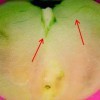Abstract
What is a rapid postharvest decay? Water-soaked lesions begin within 12 to 18 hours after harvest and continue to develop, producing large amounts of fluids. The decay spreads within cartons of tomatoes, producing wet patches in the bottom and sides of the container, a condition called “wet-boxes.” Affected fruit are out-of-grade either prior to shipment or upon arrival at the receiver. This revised 5-page fact sheet was written by J. A. Bartz, S. A. Sargent, and D. J. Huber, and published by the UF Department of Horticultural Sciences, December 2014. (Photo: S. R. Bartz)
References
IPM Guide for Florida Tomato and Pepper Production. https://edis.ifas.ufl.edu/topic_series_ipm_guide_for_florida_tomato_and_pepper_production.
Identifying and Controlling Postharvest Tomato Diseases in Florida. HS866. Gainesville: University of Florida Institute of Food and Agricultural Sciences. http://edis.ifas.ufl.edu/HS131.
Physiological, Nutritional and Other Disorders of Tomato Fruit. HS-954. Gainesville: University of Florida Institute of Food and Agricultural Sciences. http://edis.ifas.ufl.edu/hs200.

